Intel's Haswell Architecture Analyzed: Building a New PC and a New Intel
by Anand Lal Shimpi on October 5, 2012 2:45 AM ESTPlatform Retargeting
Since the introduction of Conroe/Merom back in 2006 Intel has been prioritizing notebooks for the majority of its processor designs. The TDP target for these architectures was set around 35 - 45W. Higher and lower TDPs were hit by binning and scaling voltage. The rule of thumb is a single architecture can efficiently cover an order of magnitude of TDPs. In the case of these architectures we saw them scale all the way up to 130W and all the way down to 17W.

In the middle of 2011 Intel announced its Ultrabook initiative, and at the same time mentioned that Haswell would shift Intel's notebook design target from 35 - 45W down to 10 - 20W.
At the time I didn't think too much about the new design target, but everything makes a lot more sense now. This isn't a "simple" architectural shift, it's a complete rethinking of how Intel approaches platform design. More importantly than Haswell's 10 - 20W design point, is the new expanded SoC design target. I'll get to the second part shortly.
Platform Power
There will be four client focused categories of Haswell, and I can only talk about three of them now. There are the standard voltage desktop parts, the mobile parts and the ultra-mobile parts: Haswell, Haswell M and Haswell U. There's a fourth category of Haswell that may happen but a lot is still up in the air on that line.
Of the three that Intel is talking about now, the first two (Haswell/Haswell M) don't do anything revolutionary on the platform power side. Intel is promising around a 20% reduction in platform power compared to Sandy Bridge, but not the order of magnitude improvement it promised at IDF. These platforms are still two-chip solutions with the SoC and a secondary IO chip similar to what we have today with Ivy Bridge + PCH.
It's the Haswell U/ULT parts that brings about the dramatic change. These will be a single chip solution, with part of the voltage regulation typically found on motherboards moved onto the chip's package instead. There will still be some VR components on the motherboard as far as I can tell, it's the specifics that are lacking at this point (which seems to be much of the theme of this year's IDF).
Seven years ago Intel first demonstrated working silicon with an on-chip North Bridge (now commonplace) and on-package CMOS voltage regulation:
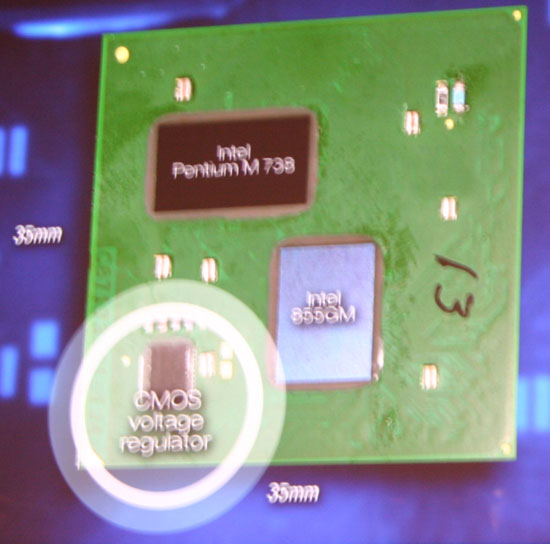
The benefits were two-fold: 1) Intel could manage fine grained voltage regulation with very fast transition times and 2) a tangible reduction in board component count.
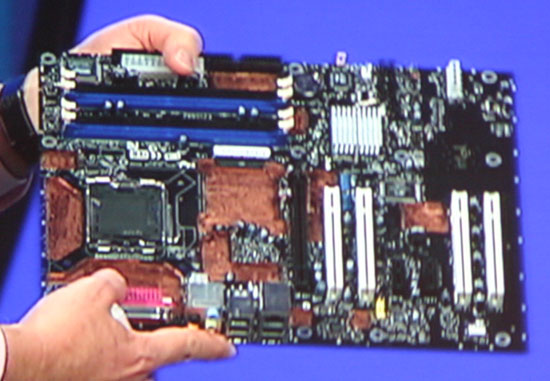
2005 - A prototype motherboard using the technology. Note the lack of voltage regulators on the motherboard and the missing GMCH (North Bridge) chip.
The second benefit is very easy to understand from a mobile perspective. Fewer components on a motherboard means smaller form factors and/or more room for other things (e.g. larger battery volume via a reduction in PCB size).
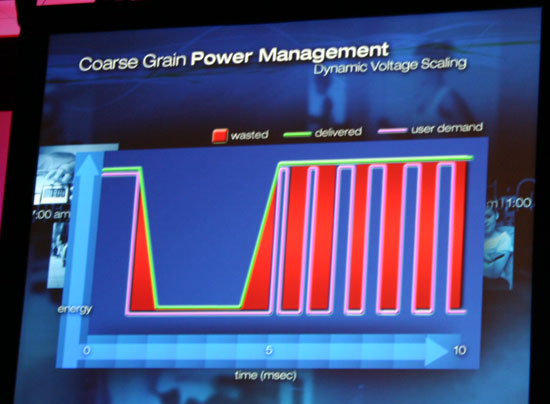

The first benefit made a lot of sense at the time when Intel introduced it, but it makes even more sense when you consider the most dramatic change to Haswell: support for S0ix active idle.


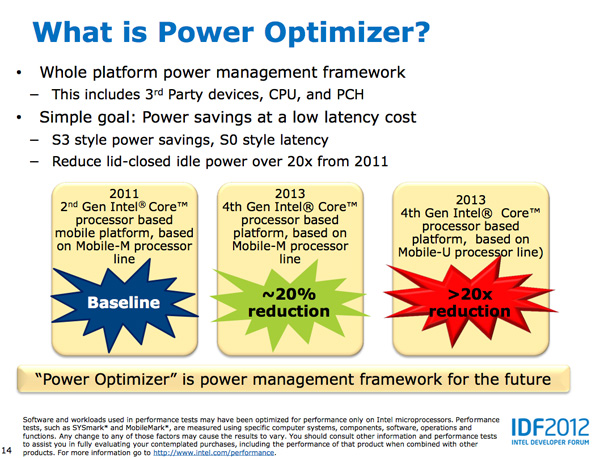
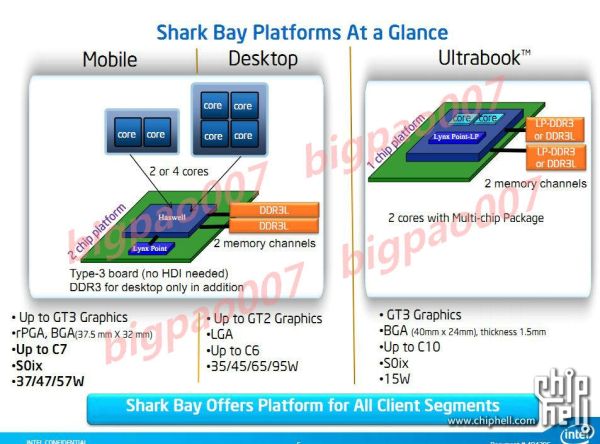








245 Comments
View All Comments
tim851 - Friday, October 5, 2012 - link
This is a perfect demonstration of the power of competition.With AMD struggling badly, Intel was content in pushing Atom. They didn't want to innovate in that sector, they sold 10 year old technology with horribly outdated chipsets. Yes, they were relatively cheap, but I was appalled.
Step in ARM, suddenly becoming a viable competitor. Now Intel moves its fat ass and tries to actually build something worthwhile.
Sadly, free markets are an illusion. Intel should pay dearly for the Atom fiasco, but they won't. Just as they didn't pay for the Pentium 4 debacle. They will come 5 years late to the party, but with all their might, they will crush ARM. ARM will fall behind, they can't keep up with that viscious tick-tock-cycle. Who can?
In 8 years, ARM will have been bought by some company, perhaps Apple. ARM will then no longer be a competitor, it will be just a different architecture, like X86. I don't see Apple having any long-term interest in designing their own hardware, it's way too unsexy. They will just cross-licence ARM with Intel and in 10 years time, Intel will rule supremely again.
UpSpin - Friday, October 5, 2012 - link
You forget that Intel vs. ARM is something bigger than AMD vs. Intel.Behind ARM stand Qualcomm, Samsung, Apple, ...
All new software is written for ARM, not Intel (x86) any longer. Microsoft releases a rewritten ARM Windows RT with a rewritten Office for ARM. Android runs on ARM and everyone supports the ARM version, while only Intel has to keep it compatible with x86.
Haswell will get released, when exactly? In a year, ARM A15 in maybe two months. Haswell has nice power savings, but it's still a Ultrabook design. The current Atom SoCs are much worse than current A9/Krait SoCs. Intel heavily optimized the software to make it look not that bad (excellent Sunspider results), but they are.
If Windows 8 is a success, Intel can be lucky. If it's not, what many expect, Intel has a real problem.
Intel is a single company building and developing their CPU/SoC. ARM SoCs get build and developed by a magnitude of companies.
If Apple can design their own ARM based SoC which has the same performance as a Haswell CPU (which is easy in the GPU area (the iPad has a faster GPU than the Intel CPUs most probably already, and with A15 and Apples A6 it's possible to get as fast with the CPU, too), they will be able to move Mac OS to ARM. This allows them to build a very very power efficient, lightweight, silent MacBook. They can port apps from iOS to MacOS and vice versa. Because they designed their SoC in-house, they don't have to fear competition the near term.
Apple always wants a monopoly, so it doesn't make sense for them to cross-license anything.
tuxRoller - Friday, October 5, 2012 - link
Unless your app is doing some serious math you can get by with just using a cross platform key chain.Frankly, the hard part is targeting the different apis that are, currently, predominating on each arch. However, assuming those don't change , and the form factor doesn't either, your new app should just be a compile away.
Kidster3001 - Monday, October 15, 2012 - link
Current ATOM SOC's are not "much worse" than A9/Krait. Most CPU benchmarks running in native code will favor the Intel SoC. It's the addition of Android/Dalvik that leans the favor back to ARM. Android has been on ARM for a lot longer and is more optimized for ARM code. Android needs to be tweaked more yet to run optimally on x86.Kidster3001 - Monday, October 15, 2012 - link
" with A15 and Apples A6 it's possible to get as fast with the CPU, too"say what? A15 and A6 are a full order of magnitude slower than Haswell. omg
Dalamar6 - Sunday, May 12, 2013 - link
Nearly all of the software on Android is junk.Apple blocks everything at a whim and gives no control.
I don't know about Windows RT, but I suspect it will suffer the same manner of crap programs Android does if it's not already.
Even if people are more focused on developing for ARM, the ARM OSes are still way behind in program availability(especially quality). And it's downright sad seeing people charging money for simple, poorly coded programs that can't even compare to existing open source x86 software.
jacobdrj - Friday, October 5, 2012 - link
I agree competition is good/great. However, how you categorize Atom is just not true! Atom filled a very real niche. Cheap mobile computing. Not powerful, but x86 and fast enough to do basic tasks. I loved my Atom netbook and used it until it bit the dust last week. Would I have liked more power? Sure, but not at the expense of (at the time) battery life. Besides, once I maxed it out by putting in a SSD and 2 GB RAM, my netbook often outpaced many peoples' newer more powerful Core based laptops for basic tasks like word processing and web browsing.Just because power users were unhappy does not mean Atom was a 'fiasco'. Those old chipsets allowed Atom netbooks to regularly sell, fully functional, for under $200, a price point that Tablets of similar capability are only just starting to hit almost 4 years later...
Don't bash Atom just because you don't fit into it's niche and don't blame Intel for HP trying to oversell Atom to the wrong customers...
Peanutsrevenge - Friday, October 5, 2012 - link
If competition is 'good/great' what does that make cooperation?Imagine the possibility of Intel and AMD working together along with Qualcomm, Imagination etc.....
Zeitgeist Movement.
Kidster3001 - Monday, October 15, 2012 - link
Intel is not going this way because "ARM stepped in". Intel is going this way because it decided to go play in ARMs playground.krumme - Friday, October 5, 2012 - link
My Samsung 9 series x3c (ivy bridge), have a usage looking on this page with wifi at bt on ranging from 4.9W to 9.9W from lowest to higest screen brightness, with a normal usage of screen of 7.2W with good brightness (using samsung own measuring tool).So screen is by far the most important component on a modern machine. In the complete ecosystem i wonder if it matter how efficient Haswell is. The benefit of 10W tdp for say the same performance is nice, but does it really matter for the market effect. And the idle power is already plenty low.
I doubt Haswell will have an significant impact - as nice as it is. This is just to late and way to expensive for the mass market. Those days are over.
At the time it hits market dirt cheap TSMC 28nm A15 and bobcat successor hits the market for next to nothing, and will give 99% of the consumers the same benefits.